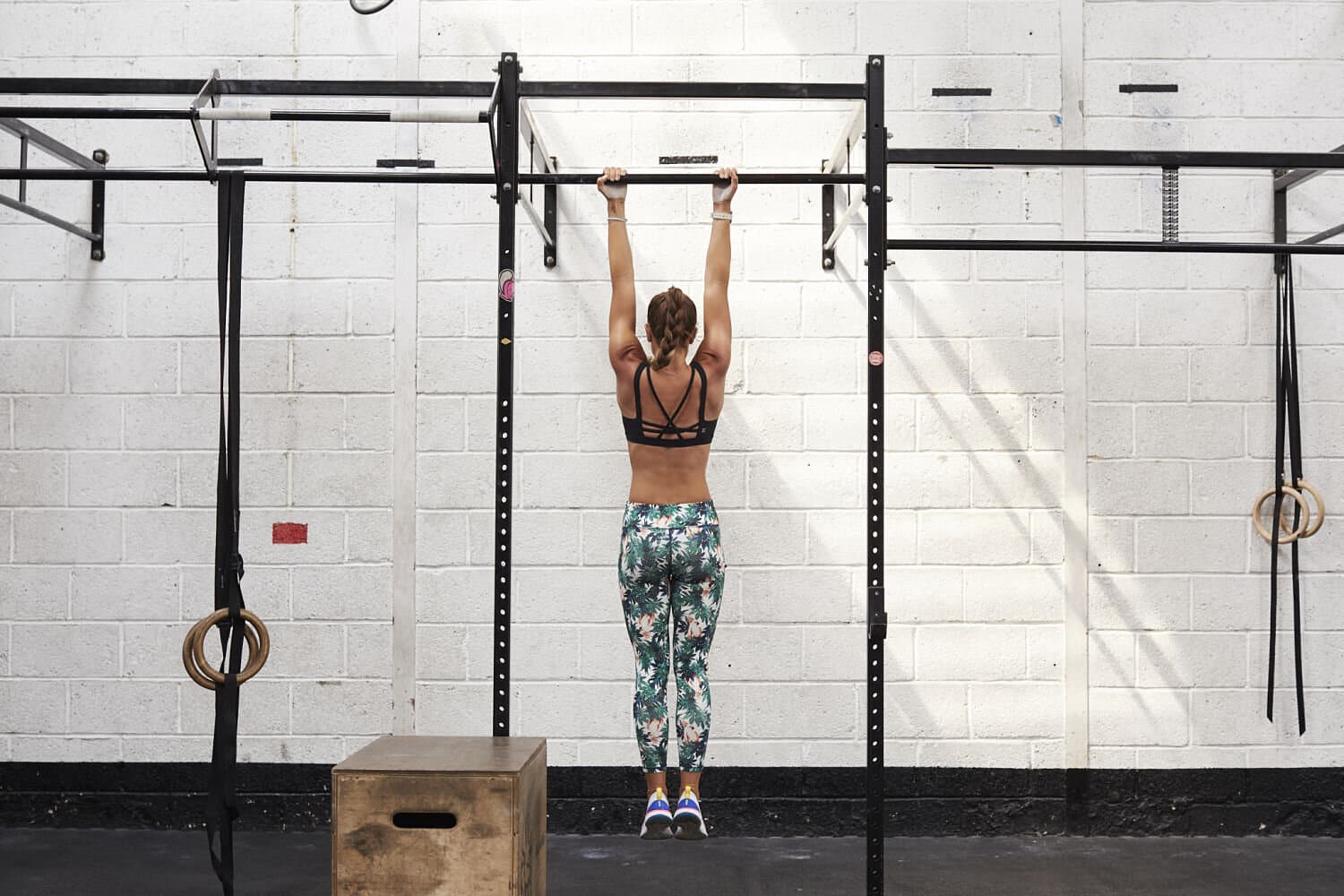Benefits, Variations, and Injury Prevention
It’s safe to say that dead hangs are one of the most underrated exercises in fitness. Though they might seem simple (after all you’re just hanging from a bar) the benefits are surprisingly far-reaching. Whether you’re looking to build grip strength, improve shoulder mobility, decompress your spine, or even strengthen your core, dead hangs can help.

In this complete guide, we’ll take a dive into the numerous benefits of dead hangs, explain how to perform them safely, and, to keep things interesting, we’ll take a look at variations like active vs passive hanging and different grip styles. Plus, we’ll cover how to prevent injuries and build up to an impressive 2-minute dead hang. So, whether you’re a desk worker looking for a long term fix for your back pain, or a seasoned athlete wanting incremental gains, the dead hang is a great exercise to add to your daily routine.
What Are Dead Hangs?
Dead hangs involve gripping onto a bar with your arms extended and allowing your body to hang freely. It’s as simple as that. But don’t be fooled – while it might seem like you’re not doing much, you’re actually giving your upper body, core, and even your mind a solid workout. There’s no pulling involved like in chin-ups or pull-ups, instead the goal is to hold on and feel the stretch throughout your body.
Top Benefits of Adding Dead Hangs to Your Routine
1. Strengthens Your Grip
Having a strong grip isn’t just useful in the gym—it’s essential for many everyday tasks, too. Whether you’re carrying groceries or opening a tough jar, dead hangs can improve the endurance of your hands and forearms, making these tasks easier.
2. Improves Shoulder Flexibility
If you experience tight shoulders or have trouble with overhead movements, dead hangs can help open up your shoulder joints. By simply hanging, you’re allowing gravity to stretch out the muscles and tissues in your shoulders, increasing your range of motion over time.
3. Relieves Pressure on the Spine
Many of us spend hours each day sitting, which can compress the spine and lead to discomfort. Hanging from a bar helps counteract this by gently stretching the spine and taking pressure off your back. Over time, regular dead hangs can help reduce back pain and improve posture.
4. Engages Your Core
Even though dead hangs seem like an upper-body exercise, your core muscles play an important role. Keeping your body stable while hanging requires your abs and lower back to work together, leading to a stronger core.
5. Better Posture
If you find yourself slouching, dead hangs can be a game changer. The exercise helps realign your spine and shoulders, leading to improved posture. Over time, it can help you stand taller and reduce the strain caused by poor alignment.
6. Mental Focus and Resilience
Dead hangs aren’t just a physical exercise—they test your mental toughness too. Holding onto the bar for an extended period challenges your focus and determination. Many people find that dead hangs help clear their mind, making it almost a form of moving meditation.
How to Build Up to a 2-Minute Dead Hang
If holding a dead hang for 2 minutes sounds challenging, don’t worry. Here’s a step-by-step guide to help you gradually increase your endurance:
Start with Shorter Intervals
Begin by aiming for 15- to 30-second dead hangs. Focus on maintaining good form, keeping your core engaged, and controlling your breathing. Do 2 to 3 sets, allowing for a minute or so of rest between sets.
Increase Time by Small Increments
Once you’re comfortable hanging for 30 seconds, start adding 5 to 10 seconds to each set every week. Consistency is key—practice 3 to 4 times a week to see steady progress.
Incorporate Grip Strength Exercises
If you’re struggling to hold on for longer periods, work on your grip strength separately. Farmers’ carries, forearm exercises, or squeezing a stress ball can all help build the endurance needed to grip the bar for a full 2 minutes.
Focus on Your Breathing
Hanging for extended periods can be as much a mental challenge as it is physical. To keep yourself calm and reduce the urge to let go, focus on controlled, steady breathing. Deep breathing helps keep your muscles relaxed and prevents premature fatigue.
Use Active Recovery Between Sets
Instead of just resting between dead hangs, use that time to shake out your arms and do gentle stretches. This keeps your muscles loose and helps prevent cramping or stiffness during your next set.
Gradually Reduce Rest Time
As your endurance improves, you can begin reducing the rest time between sets. This builds both physical and mental stamina, helping you prepare for longer hangs.
By following these steps consistently, you’ll find yourself able to hold a dead hang for 2 minutes in no time. Remember, progress might be slow at first, but patience and persistence will get you there.
How to Do a Dead Hang Properly
Get a solid grip: Find a sturdy bar and grab it with both hands. Your grip should be about shoulder-width apart.
Let your body hang: With your feet off the ground, let your body relax into the stretch. Keep your shoulder blades slightly engaged to protect your shoulders.
Keep your form tight: Stay straight from head to toe, and don’t forget to engage your core to maintain good form.
Time yourself: Start by holding for 20–30 seconds and gradually build up from there as your grip strength improves.
Modified dead hang for beginners
Jane Chertoff from Healthline suggests that if you’re new to dead hangs, you should focus on proper overhead grip form before actually hanging. You can practice the grip while standing on a bench or step while gripping the bar. Then gradually reduce the height of the step so that you can reach the bar on tip toes.
She adds that once you have your grip down, you can perform modified dead hangs on an assisted pullup machine in the gym. The added resistance will help you master the move before performing dead hangs unassisted.
Who Should Try Dead Hangs?
Dead hangs are for anyone, whether you’re just starting your fitness journey or you’re an experienced athlete. If you want better grip strength, improved mobility, or relief from back and shoulder pain, this exercise can help.
It’s a particularly good exercise for anyone whose work involves sitting at a desk. Hanging from a bar is wonderful for decompressing the spine and a great antidote to being hunched over a laptop for long periods.
Just remember to consult a health professional if you have any pre-existing injuries, especially in the shoulders or spine.
Active vs Passive Hanging and Grip Variations
When it comes to dead hangs, there are a few variations that can target different muscles and serve different purposes. Understanding the differences between active vs passive hanging and the impact of pronated vs supinated grip can help you get more out of this simple yet effective exercise.
Active Hanging vs Passive Hanging
1. Active Hanging
In an active hang, you’re actively engaging the muscles around your shoulders, back, and core. Rather than letting your body simply hang from the bar, you pull your shoulder blades down and slightly engage your lats (the large muscles along your back). This creates stability in your shoulder joints and helps you build strength, particularly in your upper back, shoulders, and core.
Key Benefits:
- Strengthens your shoulders and back.
- Improves shoulder stability and reduces the risk of shoulder injury.
- Engages your core muscles, which helps in building a stronger core.
- Prepares you for exercises like pull-ups and chin-ups by increasing your shoulder endurance and control.
How to do it:
- Grip the bar with your hands shoulder-width apart.
- Engage your core and pull your shoulder blades down and back, away from your ears.
- Keep your body in a straight line, with your feet off the ground.
- Hold this position while keeping your shoulders active throughout the duration of the hang.
2. Passive Hanging
In a passive hang, you simply allow your body to hang from the bar without engaging your shoulder blades or back muscles. This form is often used for spinal decompression and to increase flexibility in the shoulders and upper body. It’s more of a stretch than an active strength-building exercise, and it’s great for recovery after exercise.
Key Benefits:
- Stretches and decompresses your spine, relieving pressure after long periods of sitting or strenuous activity.
- Increases flexibility in your shoulders and upper body.
- Helps release tension in your back and shoulders, aiding in recovery.
How to do it:
- Grip the bar and let your body hang completely, with no active muscle engagement in your shoulders or back.
- Relax your shoulders and allow them to rise toward your ears.
- Keep your arms extended and your body loose.
- Hold this position for as long as comfortable.
While passive hanging focuses more on stretching and mobility, active hanging is ideal for building strength and stability. Both variations are useful, depending on your goals, and can be alternated in a well-rounded fitness routine.
Pronated vs Supinated Grip
Your grip on the bar can also make a big difference in which muscles are worked during a dead hang. The two primary grips are pronated and supinated, and each has unique benefits.
1. Pronated Grip (Overhand)
In a pronated grip, your palms face away from you, with your knuckles on top of the bar. This is the most common grip used in dead hangs and many other exercises like pull-ups.
Key Benefits:
- Focuses on your forearms, shoulders, and upper back.
- Builds grip strength in a way that prepares you for pull-ups and other overhand pulling exercises.
- Engages your lats more heavily, helping to develop strength in your back.
How to do it:
- Grab the bar with your palms facing away from you, slightly wider than shoulder-width apart.
- Perform either an active or passive hang, depending on your goal.
- Keep your body straight and hold for the desired duration.
2. Supinated Grip (Underhand)
In a supinated grip, your palms face toward you, with your knuckles underneath the bar. This grip is similar to the one used in chin-ups and tends to engage more of your biceps than a pronated grip.
Key Benefits:
- The supinated grip puts the focus more on your biceps and chest, making it useful if you’re looking to build arm strength.
- Can be easier for beginners who may struggle with grip strength in a pronated hang.
- Prepares your body for chin-ups, which target different muscles than pull-ups.
How to do it:
- Grab the bar with your palms facing toward you, shoulder-width apart.
- Perform either an active or passive hang.
- Hold for the desired duration, focusing on proper form.
Which Grip Should You Use?
Both pronated and supinated grips are beneficial, and incorporating both into your routine can provide a more well-rounded workout. If your goal is to improve grip strength and build your back muscles, the pronated grip is ideal. On the other hand, if you’re looking to strengthen your biceps and chest or want to prepare for chin-ups, the supinated grip is a great option.
You can also alternate grips during your hanging sessions to engage different muscle groups and keep your routine varied.
By experimenting with different hanging styles—active or passive—and switching between pronated and supinated grips, you’ll be able to target various muscles and improve both strength and mobility.
Mixing it up in this way keeps the dead hang interesting, when otherwise it can be put in the too boring to bother with box. And, if you can make it a regular part of your fitness routine, you’ll soon start to reap the benefits.
Injury Prevention: How to Safely Perform Dead Hangs
While dead hangs are a relatively low-impact exercise, it’s essential to perform them with proper form to avoid injury. If done incorrectly or pushed too hard too soon, dead hangs can lead to strain or injury, especially if you have pre-existing conditions. Let’s look at the most common injuries associated with dead hangs and how you can prevent them.
Possible Injuries from Dead Hangs
Shoulder and Elbow Pain
Improper form while hanging can place excessive stress on your shoulders and elbows. This is especially true if you already have a history of shoulder or elbow injuries. If your shoulders are not engaged and you’re simply hanging loosely, the weight of your body can pull on the joints, increasing the risk of strains, inflammation, or even more serious issues like tendonitis.
Prevention Tips:
- Engage your shoulders: Instead of letting your shoulders rise to your ears, slightly engage them by pulling your shoulder blades down and back. This stabilizes the shoulder joint and prevents excess strain.
- Warm up beforehand: Make sure to warm up your shoulder joints with mobility exercises before attempting dead hangs, especially if you’re prone to shoulder discomfort.
- Start small: Begin with shorter hangs and work your way up to avoid overloading your shoulder and elbow joints too quickly.
Wrist Strain
Hanging from a bar requires a strong grip, which puts a lot of pressure on your wrists. If your wrists aren’t strong enough to support your body weight, you may experience strain or discomfort. Those with a history of wrist injuries should be particularly cautious when starting dead hangs.
Prevention Tips:
- Strengthen your grip gradually: Before progressing to full dead hangs, you can build wrist and grip strength through exercises like wrist curls, squeezing a stress ball, or using grip trainers.
- Ensure proper grip form: Make sure your hands are positioned correctly on the bar, with your palms fully gripping the bar and not hanging solely from your fingers. A full grip helps distribute the weight evenly across your hand and wrist.
- Avoid overexertion: If you start to feel strain or fatigue in your wrists, take a break. Overexertion can lead to long-term issues, so it’s better to stop early and gradually build strength over time.
Lower Back and Core Discomfort
Though less common, poor form during dead hangs can also strain the lower back if your core isn’t engaged. Hanging with an overly arched back can put undue pressure on your spine, leading to discomfort or even injury.
Prevention Tips:
- Engage your core: Keep your abs tight and avoid letting your lower back arch excessively. This helps keep your spine in a neutral, protected position.
- Control your posture: Maintain a straight line from head to toe, keeping your body in alignment without sagging or arching.
General Tips for Injury-Free Dead Hangs
Listen to your body
If you feel any sharp pain or discomfort while hanging, stop immediately. Pain is a signal that something is wrong and pushing through it can lead to injury.
Progress gradually
If you’re new to dead hangs, start with shorter durations and gradually build up as your strength improves. Jumping into long hangs too quickly can overload your joints and muscles, increasing the risk of injury.
Consult a professional
If you have a history of joint or muscle injuries, it’s a good idea to consult a doctor or physiotherapist before adding dead hangs to your routine. They can guide you on how to perform the exercise safely based on your specific needs.
By following these injury prevention tips and focusing on good form, you can enjoy all the benefits of dead hangs without the risk of hurting yourself.
Final Thoughts
So there we have it, dead hangs are a deceptively simple yet highly effective exercise that can improve your overall strength, mobility, and posture. Whether you’re incorporating active or passive hangs, or experimenting with different grips, this exercise offers versatility and accessibility to all fitness levels.
By following proper form and understanding the potential risks, you can safely enjoy the benefits of dead hangs while protecting your body from injury.
If you’re able to build dead hanging into your regular exercise routine, you’ll soon notice improvements in grip strength, shoulder stability, core engagement, and even mental toughness.
So, grit your teeth and get hanging and with a bit of patience and practice you’ll be hanging out with Olympic gymnasts before you know it (for 2-minutes at least!).


